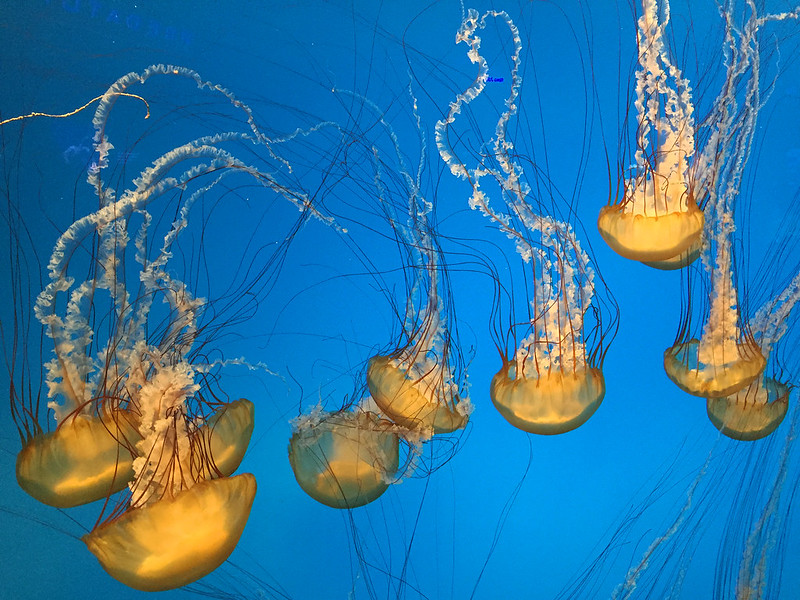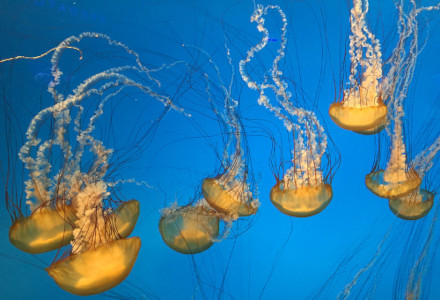
Photographer: Judy Gallagher
CC License: https://bit.ly/3yQoalM
Pacific Sea Nettle Facts
- Firstly, the Pacific Sea Nettle remains an ocean-dwelling species which many mistakenly consider dangerous. However, this marvelous creature actually poses no serious threat to humans. In fact, barring an allergic reaction, its sting rarely ranks as no more than irritating.
- Secondly, since it represents a multi-stage life form, this creature actually evolved the ability to reproduce in different ways. That holds true because individuals can reproduce sexually in a total of two ways. That’s sexually in the medusa stage, and asexually in the polyp stage.
- Meanwhile, this marvelous creature separates itself from others in another way. While many species have dwindled in recent decades, the Pacific Sea Nettle has actually increased in numbers. In parts of its range, its numbers have become considered hazardous to boating.
- In addition, for the moment, at least, this amazing species does not appear on the Red List of Threatened Species, published by the IUCN. This holds true because its numbers actually appear to be either stable, or perhaps increasing. Nevertheless, it remains considered to be at risk due to ongoing climate change.
Related Articles
Tiburonia Turritopsis Nutricula Fried Egg Jellyfish
Photographer: Ed Bierman
CC License: https://bit.ly/3gajsbh
Pacific Sea Nettle Physical Description
Although it amazes due to its great beauty, among other reasons, the Pacific Sea Nettle only ranks as a medium-sized species of true jellyfish. The species hold this ranking because of the size of its bell. This quite impressive feature of the creature attains a maximum diameter of just over 3 ft (1 m). Further, it typically displays a distinctive golden-brown color with a reddish tint.
The remarkable animal known as the Pacific Sea Nettle also has long white oral arms. Furthermore, it also develops 24 mobile, maroon colored tentacles. These fascinating appendages sometimes attain lengths of as much as 15 ft (4.6 m). In addition, each of those tentacles contains thousands of tiny stingers. These the creature uses to inject its venom into the prey.
- Kingdom: Animalia
- Phylum: Cnidaria
- Class: Scyphozoa
- Order: Semaeostomeae
- Family: Pelagiidae
- Genus: Chrysaora
- Species: C. fuscescens
Photographer: Guillaume Paumier
CC License: https://bit.ly/3g9nu3N
Pacific Sea Nettle Distribution, Habitat, and Ecology
Quite unfortunately, the endemic range of the beautiful Pacific Sea Nettle remains somewhat restricted. That’s because, as the name implies, it consists of a rather specific portion of the Pacific Ocean. More specifically, however, this endemic habitat range extends from the coast of Mexico to Canada, in North America.
First of all, the impressive creatures possess the ability to dwell at comparatively moderate depths. Nevertheless, the vast majority of individuals typically remain near the surface. What’s more, the species typically prefers to float on the surface, allowing the waves to move them.
While there, the resourceful animal spreads its versatile tentacles wide and consumes captured prey. This prey most commonly consists of a combination of zooplankton, crustaceans, and various small fish. In turn, the Pacific Sea Nettle itself often falls prey to either seabirds or large fish.
Finally, in recent years, the animal has become extremely plentiful off the coast of Oregon, in the United States. Although scientists have not determined the reason for this, one leading theory suggests that current environmental factors may play a key role in this quite surprising development.
Species Sharing Its Range
California Sea Lion Vaquita California Sheephead
Check out our articles on 7 Outstanding Flightless Birds of the World, Mountain Chicken, Plitvice Lakes, Bismarck Palm, Golden Armadillo Lizard, Six-Spotted Fishing Spider

